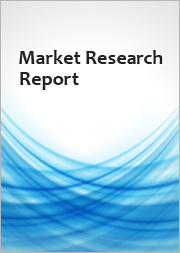
|
시장보고서
상품코드
1702329
세계의 해저 매니폴드 시장(-2032년) : 유형, 수심, 용도, 제조 기술, 지역별Global Subsea Manifolds Market Research Report By Type, By Water Depth, By Application, Manufacturing Techniques, and By Regional Forecast to 2032 |
||||||
해저 매니폴드 시장 규모는 2024-2032년에 약 4.8%의 CAGR로 성장할 것으로 예측됩니다.
해저 석유 및 가스 탐사 및 생산에 대한 수요 증가는 해저 매니폴드 시장을 촉진하는 주요 요인 중 하나입니다. 모든 유형의 채굴 기술에서 심해 및 초심해로의 전환이 진행되고 있으며, 매니폴드는 기술적 유효성을 유지하는 데 필수적입니다. 또한 환경 보호와 생산량 증가에 대한 관심이 높아짐에 따라 이중 장비의 개발도 진행되고 있습니다.
특히 신흥 국가에서는 해저 매니폴드가 오프쇼어 분야에서 일정한 성장 기회를 제공합니다. 지속적인 기술 발전으로 이러한 시스템은 더 높은 성능을 발휘하고 모니터링 기능도 강화될 것이 분명합니다. 또한 전략적 제휴와 중요한 연구에 대한 투자를 통해 보다 효과적인 공동 기술이 등장할 것으로 예상됩니다. 에너지 업계는 현재 재생 에너지 자원을 다양한 시스템에 통합하는 방법에 초점을 맞추기 시작했으며, 해상 풍력발전의 활용이 그 한 예입니다.
지역별 전망
2023년 시장 규모는 북미가 5억 달러, 중동 및 아프리카가 4억 6,000만 달러로 추정되며, 해저 매니폴드 시장은 지역별로 큰 차이를 보이고 있습니다. 아시아태평양은 3억 달러, 유럽은 4억 5,000만 달러, 남미는 상대적으로 작은 1억 5,000만 달러로 나타났습니다. 북미는 첨단 해저 기술 도입으로 시장을 선도하고 있으며, 2032년에는 8억 5,000만 달러에 달할 것으로 예상됩니다. 유럽은 오프쇼어 프로젝트에 대한 강력한 투자로 7억 5,000만 달러 규모로 성장할 가능성이 높으며, 향후 확대가 예상됩니다.
에너지 소비 증가와 해양 탐사 프로젝트 확대로 인해 아시아태평양은 5억 5,000만 달러까지 성장할 것으로 예상됩니다. 남미와 중동 및 아프리카도 각각 2억 5,000만 달러, 7억 달러까지 성장할 것으로 예상되며, 두 지역 모두 미개발 자원과 오프쇼어 벤처의 잠재력을 활용하고 있습니다. 이를 통해 해저 매니폴드 시장은 지역별로 다른 성장 패턴과 전략적 투자 기회, 기술 혁신에 따라 영향을 받는 특성을 가진 산업임을 알 수 있습니다.
세계의 해저 매니폴드 시장을 조사했으며, 시장의 정의와 개요, 시장 성장에 대한 각종 영향요인의 분석, 시장 규모 추이·예측, 각종 구분·지역/주요 국가별 내역, 경쟁 환경, 주요 기업의 개요 등을 정리하여 전해드립니다.
목차
제1장 개요
제2장 시장 개요
제3장 조사 방법
제4장 시장 역학
- 촉진요인
- 오프쇼어 석유 및 가스 탐사 활동의 증가
- 심해 및 초심해 개발의 수요 증가
- 억제요인
- 고액의 초기 자본 투자
- 기회
- 신흥 시장에서 해저 인프라의 확대
- COVID-19의 영향 분석
- 러시아·우크라이나 전쟁의 영향 분석
제5장 시장 요인 분석
- 공급망 분석
- Porter's Five Forces 모델
- PESTEL 분석
- 규제 구조
- 기술의 진보
제6장 세계의 해저 매니폴드 시장 : 유형별
- 개요
- 템플릿 매니폴드
- 클러스터 매니폴드
- 파이프라인 엔드 매니폴드(PLEM)
제7장 세계의 해저 매니폴드 시장 : 용도별
- 프로덕션 매니폴드
- 인젝션 매니폴드
제8장 세계의 해저 매니폴드 시장 : 수심별
- 천해역
- 심수역
제9장 세계의 해저 매니폴드 시장 : 제조 기술별
- 분말야금 및 열간 등방압가압(PM HIP)
- 기존 기술
제10장 세계의 해저 매니폴드 시장 : 지역별
- 개요
- 북미
- 미국
- 캐나다
- 멕시코
- 유럽
- 노르웨이
- 영국
- 덴마크
- 독일
- 이탈리아
- 네덜란드
- 튀르키예
- 기타
- 아시아태평양
- 중국
- 인도
- 태국
- 인도네시아
- 말레이시아
- 베트남
- 호주
- 기타
- 남미
- 브라질
- 가이아나
- 기타
- 중동 및 아프리카
- UAE
- 사우디아라비아
- 카타르
- 앙골라
- 이집트
- 나이지리아
- 기타
제11장 경쟁 구도
- 2023년 시장 점유율 분석
- 경쟁 대시보드
- 공개 기업의 주식 요약
- 비교 분석 : 주요 기업의 재무
- 주요 개발과 성장 전략
제12장 기업 개요
- SLB
- AKER SOLUTIONS
- TECHNIPFMC PLC
- SUBSEA7
- OCEANEERING INTERNATIONAL, INC.
Global Subsea Manifolds Market Research Report By Type (Template Manifold, Cluster Manifold, and Pipeline End Manifold (PLEM)), By Water Depth (Shallow Water and Deep Water), By Application (Production Manifolds and Injection Manifolds), Manufacturing Techniques (Powder Metallurgy and Hot Isostatic Pressing (PM HIP) and Traditional), and By Regional (North America, Europe, South America, Asia Pacific, Middle East and Africa) Forecast to 2032
Overview of the Market
The Subsea Manifolds Market is anticipated to develop at a CAGR (growth rate) of approximately 4.8% from 2024 to 2032, according to MRFR analysis.
The increasing need for undersea oil and gas exploration and production is one of the major reasons driving the subsea manifolds market. In all types of extraction techniques, there is a shift to deep water and ultra-deep water, where manifolds are essential to preserving technological effectiveness. Additionally, the development of dual equipment is based on the growing concern for environmental protection and greater production.
Particularly in emerging nations, the Subsea Manifolds sector offers some opportunity in the offshore sector. It is clear that these systems will work better and have greater monitoring capabilities as a result of the ongoing technological improvements. Furthermore, more effective co-technologies will emerge as a result of strategic alliances and investments in important research. The energy industry has now started to focus on investigating ways to incorporate renewable resources into their various systems, using offshore wind farms as one example.
Perspectives on Market Segments
The Subsea Manifolds market is divided into three segments based on type: Pipeline End Manifold (PLEM), Cluster Manifold, and Template Manifold.
The subsea manifolds market is divided into two segments based on application: production manifolds and injection manifolds.
The Subsea Manifolds market is divided into two segments based on water depth: shallow water and deep water.
The Subsea Manifolds market is divided into two segments based on manufacturing techniques: Powder Metallurgy and Hot Isostatic Pressing (PM HIP) and Traditional.
Regional Perspectives
With 2023 estimations of 0.5 USD billion in North America and MEA at 0.46 USD billion, the Subsea Manifolds Market exhibits significant geographical variation. APAC makes for 0.3 USD billion of the market, while Europe is at 0.45 USD billion. With a worth of 0.15 USD billion, South America makes up a lower portion. With a majority stake in the industry that is expected to reach 0.85 USD billion by 2032, North America leads the way thanks to its sophisticated subsea technology implementation. Europe has a lot of room to grow, with strong offshore project investments contributing to its 0.75 USD billion growth.
Due to rising energy consumption and offshore exploration projects, APAC is expected to rise by 0.55 USD billion. Both regions are leveraging their unexplored resources and offshore venture potential, with South America and MEA predicted to reach 0.25 USD billion and 0.7 USD billion, respectively. Therefore, the Subsea Manifolds Market business is distinguished by various geographical significance and growth trajectories that are impacted by strategic investment opportunities and technological advancements.
Key Players
Oceaneering International, JDR Cable Systems, National Oilwell Varco, PRC Engineering, Saipem, Baker Hughes, Aker Solutions, Halliburton, Schlumberger, Flexibles, TechnipFMC, Subsea 7, FMC Technologies, Wood Group, and Kongsberg Gruppen are some of the major players in the subsea manifolds market.
TABLE OF CONTENTS
1 EXECUTIVE SUMMARY
2 STUDY INTRODUCTION
- 2.1 DEFINITION
- 2.2 SCOPE OF THE STUDY
- 2.3 RESEARCH OBJECTIVE
- 2.4 MARKET STRUCTURE
3 RESEARCH METHODOLOGY
- 3.1 OVERVIEW
- 3.2 DATA FLOW
- 3.2.1 Data Mining Process
- 3.3 PURCHASED DATABASE:
- 3.4 SECONDARY SOURCES:
- 3.4.1 Secondary Research data flow:
- 3.5 PRIMARY RESEARCH:
- 3.5.1 Primary Research DATA FLOW:
- 3.6 APPROACHES FOR MARKET SIZE ESTIMATION:
- 3.6.1 Revenue Analysis Approach
- 3.7 DATA FORECASTING
- 3.7.1 Data forecasting Type
- 3.8 DATA MODELING
- 3.8.1 microeconomic factor analysis:
- 3.8.2 Data modeling:
- 3.9 TEAMS AND ANALYST CONTRIBUTION
4 MARKET DYNAMICS
- 4.1 INTRODUCTION
- 4.2 DRIVERS
- 4.2.1 Increasing Offshore Oil and Gas Exploration Activities
- 4.2.2 Growing Demand for Deepwater and Ultra-deepwater Developments
- 4.3 RESTRAINTS
- 4.3.1 High Initial Capital Investment
- 4.4 OPPORTUNITY
- 4.4.1 Expansion of Subsea Infrastructure in Emerging Markets
- 4.5 IMPACT ANALYSIS OF COVID - 19
- 4.6 RUSSIA-UKRAINE WAR IMPACT ANALYSIS
5 MARKET FACTOR ANALYSIS
- 5.1 SUPPLY CHAIN ANALYSIS
- 5.2 PORTER'S FIVE FORCES MODEL
- 5.2.1 Threat of New Entrants
- 5.2.2 BARGAINING POWER OF SUPPLIERS
- 5.2.3 Threat of Substitutes
- 5.2.4 Bargaining Power of Buyers
- 5.2.5 Intensity of Rivalry
- 5.3 PESTEL ANALYSIS
- 5.4 REGULATORY FRAMEWORK
- 5.4.1 International Maritime Organization (IMO)
- 5.4.2 HEALTH AND SAFETY REGULATIONS
- 5.4.3 Pressure Equipment and Material Standards
- 5.4.4 Deepwater and Ultra-Deepwater Compliance
- 5.5 TECHNOLOGICAL ADVANCEMENT
- 5.5.1 Advanced Materials for High-Pressure and High-Temperature (HPHT) Environments
- 5.5.2 Digital Twin Technology
- 5.5.3 Autonomous Underwater Vehicles (AUVs) and Remotely Operated Vehicles (ROVs)
6 GLOBAL SUBSEA MANIFOLDS MARKET, BY TYPE
- 6.1 OVERVIEW
- 6.2 TEMPLATE MANIFOLD
- 6.3 CLUSTER MANIFOLD
- 6.4 PIPELINE END MANIFOLD (PLEM)
7 GLOBAL SUBSEA MANIFOLDS MARKET, BY APPLICATION
- 7.1 INTRODUCTION
- 7.2 PRODUCTION MANIFOLDS
- 7.3 INJECTION MANIFOLDS
8 GLOBAL SUBSEA MANIFOLDS MARKET, BY WATER DEPTH
- 8.1 INTRODUCTION
- 8.2 SHALLOW WATER
- 8.3 DEEP WATER
9 GLOBAL SUBSEA MANIFOLDS MARKET, BY MANUFACTURING TECHNIQUES
- 9.1 INTRODUCTION
- 9.2 POWDER METALLURGY AND HOT ISOSTATIC PRESSING (PM HIP)
- 9.3 TRADITIONAL
10 GLOBAL SUBSEA MANIFOLDS MARKET, BY REGION
- 10.1 OVERVIEW
- 10.2 NORTH AMERICA
- 10.2.1 US
- 10.2.2 CANADA
- 10.2.3 MEXICO
- 10.3 EUROPE
- 10.3.1 NORWAY
- 10.3.2 UK
- 10.3.3 DENMARK
- 10.3.4 GERMANY
- 10.3.5 ITALY
- 10.3.6 NETHERLANDS
- 10.3.7 TURKEY
- 10.3.8 REST OF EUROPE
- 10.4 ASIA-PACIFIC
- 10.4.1 CHINA
- 10.4.2 INDIA
- 10.4.3 THAILANDS
- 10.4.4 INDONESIA
- 10.4.5 MALAYSIA
- 10.4.6 VIETNAM
- 10.4.7 AUSTRALIA
- 10.4.8 REST OF ASIA-PACIFIC
- 10.5 SOUTH AMERICA
- 10.5.1 BRAZIL
- 10.5.2 GUYANA
- 10.5.3 REST OF SOUTH AMERICA
- 10.6 MIDDLE EAST & AFRICA
- 10.6.1 UAE
- 10.6.2 SAUDI ARABIA
- 10.6.3 QATAR
- 10.6.4 ANGOLA
- 10.6.5 EGYPT
- 10.6.6 NIGERIA
- 10.6.7 REST OF MEA
11 COMPETITIVE LANDSCAPE
- 11.1 INTRODUCTION
- 11.2 MARKET SHARE ANALYSIS, 2023
- 11.3 COMPETITOR DASHBOARD
- 11.4 PUBLIC PLAYERS STOCK SUMMARY
- 11.5 COMPARATIVE ANALYSIS: KEY PLAYERS FINANCIAL
- 11.1 KEY DEVELOPMENTS & GROWTH STRATEGIES
- 11.1.1 PARTNERSHIP
12 COMPANY PROFILES
- 12.1 SLB
- 12.1.1 COMPANY OVERVIEW
- 12.1.2 FINANCIAL OVERVIEW
- 12.1.3 PRODUCTS OFFERed
- 12.1.4 KEY DEVELOPMENTS
- 12.1.5 SWOT ANALYSIS
- 12.1.6 Key Strategies
- 12.2 AKER SOLUTIONS
- 12.2.1 COMPANY OVERVIEW
- 12.2.2 FINANCIAL OVERVIEW
- 12.2.3 PRODUCTS OFFERed
- 12.2.4 KEY DEVELOPMENTS
- 12.2.5 SWOT ANALYSIS
- 12.2.6 Key Strategies
- 12.3 TECHNIPFMC PLC
- 12.3.1 COMPANY OVERVIEW
- 12.3.2 FINANCIAL OVERVIEW
- 12.3.3 PRODUCTS OFFERed
- 12.3.4 KEY DEVELOPMENTS
- 12.3.5 SWOT ANALYSIS
- 12.3.6 Key Strategies
- 12.4 SUBSEA7
- 12.4.1 COMPANY OVERVIEW
- 12.4.2 FINANCIAL OVERVIEW
- 12.4.3 PRODUCTS OFFERed
- 12.4.4 KEY DEVELOPMENTS
- 12.4.5 Key Strategies
- 12.5 OCEANEERING INTERNATIONAL, INC.
- 12.5.1 COMPANY OVERVIEW
- 12.5.2 FINANCIAL OVERVIEW
- 12.5.3 PRODUCTS OFFERed
- 12.5.4 KEY DEVELOPMENTS
- 12.5.5 Key Strategies




















